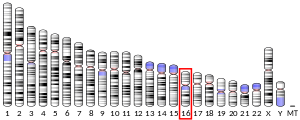Lipopolysaccharide-induced tumor necrosis factor-alpha factor is a protein that in humans is encoded by the LITAF gene.[5][6][7]
It is associated with Charcot–Marie–Tooth disease 1C.
References
edit- ^ a b c GRCh38: Ensembl release 89: ENSG00000189067 – Ensembl, May 2017
- ^ a b c GRCm38: Ensembl release 89: ENSMUSG00000022500 – Ensembl, May 2017
- ^ "Human PubMed Reference:". National Center for Biotechnology Information, U.S. National Library of Medicine.
- ^ "Mouse PubMed Reference:". National Center for Biotechnology Information, U.S. National Library of Medicine.
- ^ Polyak K, Xia Y, Zweier JL, Kinzler KW, Vogelstein B (Sep 1997). "A model for p53-induced apoptosis". Nature. 389 (6648): 300–5. Bibcode:1997Natur.389..300P. doi:10.1038/38525. PMID 9305847. S2CID 4429638.
- ^ Myokai F, Takashiba S, Lebo R, Amar S (May 1999). "A novel lipopolysaccharide-induced transcription factor regulating tumor necrosis factor alpha gene expression: molecular cloning, sequencing, characterization, and chromosomal assignment". Proc Natl Acad Sci U S A. 96 (8): 4518–23. Bibcode:1999PNAS...96.4518M. doi:10.1073/pnas.96.8.4518. PMC 16364. PMID 10200294.
- ^ "Entrez Gene: LITAF lipopolysaccharide-induced TNF factor".
External links
editFurther reading
edit- Jolliffe CN, Harvey KF, Haines BP, et al. (2001). "Identification of multiple proteins expressed in murine embryos as binding partners for the WW domains of the ubiquitin-protein ligase Nedd4". Biochem. J. 351 (3): 557–65. doi:10.1042/0264-6021:3510557. PMC 1221394. PMID 11042109.
- Moriwaki Y, Begum NA, Kobayashi M, et al. (2001). "Mycobacterium bovis Bacillus Calmette-Guerin and its cell wall complex induce a novel lysosomal membrane protein, SIMPLE, that bridges the missing link between lipopolysaccharide and p53-inducible gene, LITAF(PIG7), and estrogen-inducible gene, EET-1". J. Biol. Chem. 276 (25): 23065–76. doi:10.1074/jbc.M011660200. PMID 11274176.
- Street VA, Goldy JD, Golden AS, et al. (2002). "Mapping of Charcot-Marie-Tooth disease type 1C to chromosome 16p identifies a novel locus for demyelinating neuropathies". Am. J. Hum. Genet. 70 (1): 244–50. doi:10.1086/337943. PMC 384893. PMID 11713717.
- Strausberg RL, Feingold EA, Grouse LH, et al. (2003). "Generation and initial analysis of more than 15,000 full-length human and mouse cDNA sequences". Proc. Natl. Acad. Sci. U.S.A. 99 (26): 16899–903. Bibcode:2002PNAS...9916899M. doi:10.1073/pnas.242603899. PMC 139241. PMID 12477932.
- Street VA, Bennett CL, Goldy JD, et al. (2003). "Mutation of a putative protein degradation gene LITAF/SIMPLE in Charcot-Marie-Tooth disease 1C". Neurology. 60 (1): 22–6. doi:10.1212/wnl.60.1.22. PMID 12525712. S2CID 7495837.
- Matsuda A, Suzuki Y, Honda G, et al. (2003). "Large-scale identification and characterization of human genes that activate NF-kappaB and MAPK signaling pathways". Oncogene. 22 (21): 3307–18. doi:10.1038/sj.onc.1206406. PMID 12761501. S2CID 38880905.
- Street VA, Bennett CL, Bird TD, Chance PF (2004). "New gene for CMT". J. Peripher. Nerv. Syst. 8 (4): 206. doi:10.1111/j.1085-9489.2003.03025.x. PMID 14641644. S2CID 12117063.
- Ota T, Suzuki Y, Nishikawa T, et al. (2004). "Complete sequencing and characterization of 21,243 full-length human cDNAs". Nat. Genet. 36 (1): 40–5. doi:10.1038/ng1285. PMID 14702039.
- Ludes-Meyers JH, Kil H, Bednarek AK, et al. (2004). "WWOX binds the specific proline-rich ligand PPXY: identification of candidate interacting proteins". Oncogene. 23 (29): 5049–55. doi:10.1038/sj.onc.1207680. PMC 4143251. PMID 15064722.
- Bennett CL, Shirk AJ, Huynh HM, et al. (2004). "SIMPLE mutation in demyelinating neuropathy and distribution in sciatic nerve". Ann. Neurol. 55 (5): 713–20. doi:10.1002/ana.20094. PMID 15122712. S2CID 7719672.
- Matsumura Y, Matsumura Y, Nishigori C, et al. (2004). "PIG7/LITAF gene mutation and overexpression of its gene product in extramammary Paget's disease". Int. J. Cancer. 111 (2): 218–23. doi:10.1002/ijc.20251. PMID 15197774. S2CID 27155753.
- Gerhard DS, Wagner L, Feingold EA, et al. (2004). "The status, quality, and expansion of the NIH full-length cDNA project: the Mammalian Gene Collection (MGC)". Genome Res. 14 (10B): 2121–7. doi:10.1101/gr.2596504. PMC 528928. PMID 15489334.
- Saifi GM, Szigeti K, Wiszniewski W, et al. (2006). "SIMPLE mutations in Charcot-Marie-Tooth disease and the potential role of its protein product in protein degradation". Hum. Mutat. 25 (4): 372–83. doi:10.1002/humu.20153. PMID 15776429. S2CID 20127440.
- Meggouh F, de Visser M, Arts WF, et al. (2005). "Early onset neuropathy in a compound form of Charcot-Marie-Tooth disease". Ann. Neurol. 57 (4): 589–91. doi:10.1002/ana.20434. PMID 15786462. S2CID 32014135.
- Tang X, Marciano DL, Leeman SE, Amar S (2005). "LPS induces the interaction of a transcription factor, LPS-induced TNF-alpha factor, and STAT6(B) with effects on multiple cytokines". Proc. Natl. Acad. Sci. U.S.A. 102 (14): 5132–7. Bibcode:2005PNAS..102.5132T. doi:10.1073/pnas.0501159102. PMC 555602. PMID 15793005.
- Beauvais K, Furby A, Latour P (2006). "Clinical, electrophysiological and molecular genetic studies in a family with X-linked dominant Charcot-Marie-Tooth neuropathy presenting a novel mutation in GJB1 Promoter and a rare polymorphism in LITAF/SIMPLE". Neuromuscul. Disord. 16 (1): 14–8. doi:10.1016/j.nmd.2005.09.008. PMID 16373087. S2CID 32730191.
- Latour P, Gonnaud PM, Ollagnon E, et al. (2006). "SIMPLE mutation analysis in dominant demyelinating Charcot-Marie-Tooth disease: three novel mutations". J. Peripher. Nerv. Syst. 11 (2): 148–55. doi:10.1111/j.1085-9489.2006.00080.x. PMID 16787513. S2CID 24702162.
- Stucchi A, Reed K, O'Brien M, et al. (2007). "A new transcription factor that regulates TNF-alpha gene expression, LITAF, is increased in intestinal tissues from patients with CD and UC". Inflamm. Bowel Dis. 12 (7): 581–7. doi:10.1097/01.MIB.0000225338.14356.d5. PMID 16804395. S2CID 28836872.





